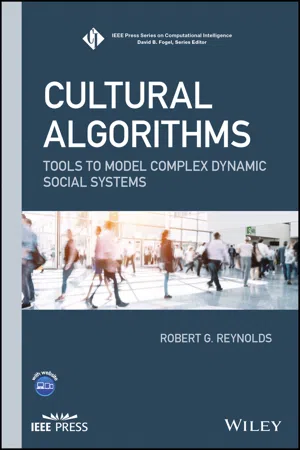
- English
- ePUB (mobile friendly)
- Available on iOS & Android
About this book
A thorough look at how societies can use cultural algorithms to understand human social evolution
For those working in computational intelligence, developing an understanding of how cultural algorithms and social intelligence form the essential framework for the evolution of human social interaction is essential. This book, Cultural Algorithms: Tools to Model Complex Dynamic Social Systems, is the foundation of that study. It showcases how we can use cultural algorithms to organize social structures and develop socio-political systems that work.
For such a vast topic, the text covers everything from the history of the development of cultural algorithms and the basic framework with which it was organized. Readers will also learn how other nature-inspired algorithms can be expressed and how to use social metrics to assess the performance of various algorithms.
In addition to these topics, the book covers topics including:
- The CAT system including the Repast Simphony System and CAT Sample Runs
- How to problem solve using social networks in cultural algorithms with auctions
- Understanding Common Value Action to enhance Social Knowledge Distribution Systems
- Case studies on team formations
- An exploration of virtual worlds using cultural algorithms
For industry professionals or new students, Cultural Algorithms provides an impactful and thorough look at both social intelligence and how human social evolution translates into the modern world.
Frequently asked questions
- Essential is ideal for learners and professionals who enjoy exploring a wide range of subjects. Access the Essential Library with 800,000+ trusted titles and best-sellers across business, personal growth, and the humanities. Includes unlimited reading time and Standard Read Aloud voice.
- Complete: Perfect for advanced learners and researchers needing full, unrestricted access. Unlock 1.4M+ books across hundreds of subjects, including academic and specialized titles. The Complete Plan also includes advanced features like Premium Read Aloud and Research Assistant.
Please note we cannot support devices running on iOS 13 and Android 7 or earlier. Learn more about using the app.
Information
1
System Design Using Cultural Algorithms
Introduction

- Cultural Algorithms inherently support multiobjective approaches to problem solving. A multiobjective problem is when there is some conflict in an agent's goals, such that the achievement of one goal takes resources away from achieving the other. Since conflicting objectives can reside simultaneously in the Belief Space, agents working on one goal may need to resolve conflicts with agents working on complementary ones. So Cultural Algorithms do not need to be restructured to explicitly deal with multiobjective problems, whereas other machine learning algorithms may need to do so.
- Cultural Algorithms inherently support population co‐evolution. Stress within the social fabric can naturally produce co‐evolving populations. New links can be created subsequently to allow the separate populations to interact again.
- Cultural Algorithms also support alternative ways to use resources through the emergence of subcultures. A subculture is defined as a culture contained within a broader mainstream culture, with its own set of goals, values, practices, and beliefs. Just as co‐evolution concerns the disconnection of individuals in the agent network, subcultures represent a corresponding separation of knowledge sources in the Belief Space into subcomponents that are linked to groups of connected individuals within the Population Space.
- Cultural Algorithms support the social context of an individual by providing mechanisms for that individual to resolve conflicts with other individuals in the population space through the use of knowledge distribution mechanisms. These mechanisms are designed to reduce conflicts between individuals through the sharing of knowledge sources that influence them. This practice can be used to modulate the flow of knowledge through the population. The use of certain distribution strategies can produce viral distributions of information on the one hand or slow down the flows of the other knowledge sources dependent on the context. This feature makes it a useful learning mechanism with regards to design of systems that involve teams of agents.
- Cultural Algorithms support the idea of a networked performance space. That is, the performance environment can be viewed as a connected collection of performance functions or performance simulators. This allows agent performance to potentially modify performance assessment and expectations.
- Cultural Algorithms can exhibit the flexibility needed to cope with the changing environments in which they are embedded. They were in fact developed to learn about how social systems evolved in complex environments [3].
- Cultural Algorithms facilitate the development of distributed systems and their supporting algorithms. The knowledge‐intensive nature of cultural systems requires the support of both distributed and parallel algorithms in the coordination of agents and their use of knowledge.
The Cultural Engine
Table of contents
- Cover
- Table of Contents
- Title Page
- Copyright Page
- List of Contributors
- About the Companion Website
- 1 System Design Using Cultural Algorithms
- 2 The Cultural Algorithm Toolkit System
- 3 Social Learning in Cultural Algorithms with Auctions
- 4 Using Common Value Auction in Cultural Algorithm to Enhance Robustness and Resilience of Social Knowledge Distribution Systems
- 5 Optimizing AI Pipelines
- 6 Cultural Algorithms for Social Network Analysis
- 7 Evolving Emergent Team Strategies in Robotic Soccer using Enhanced Cultural Algorithms
- 8 The Use of Cultural Algorithms to Learn the Impact of Climate on Local Fishing Behavior in Cerro Azul, Peru
- 9 CAPSO: A Parallelized Multiobjective Cultural Algorithm Particle Swarm Optimizer
- 10 Exploring Virtual Worlds with Cultural Algorithms
- Index
- End User License Agreement